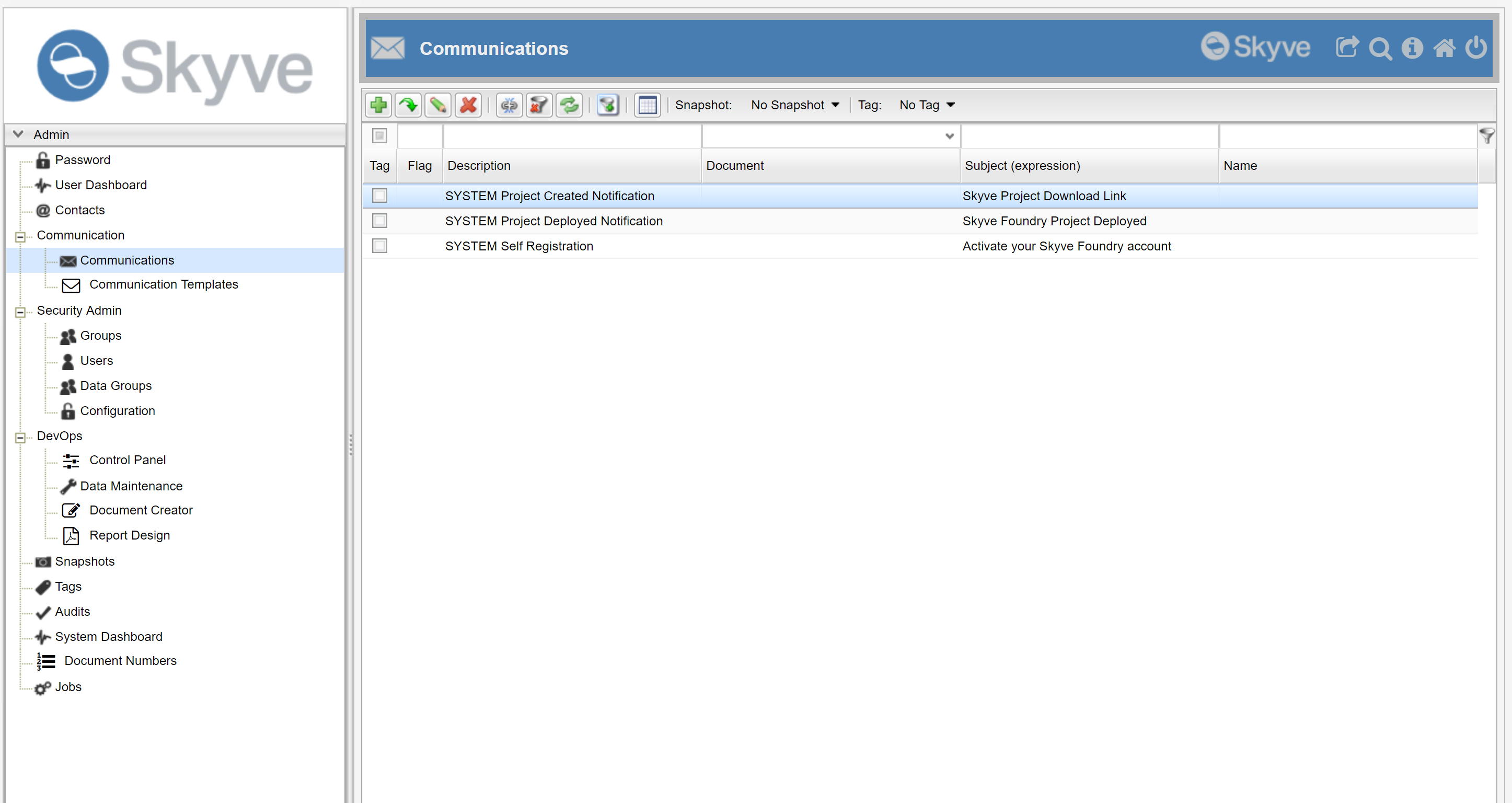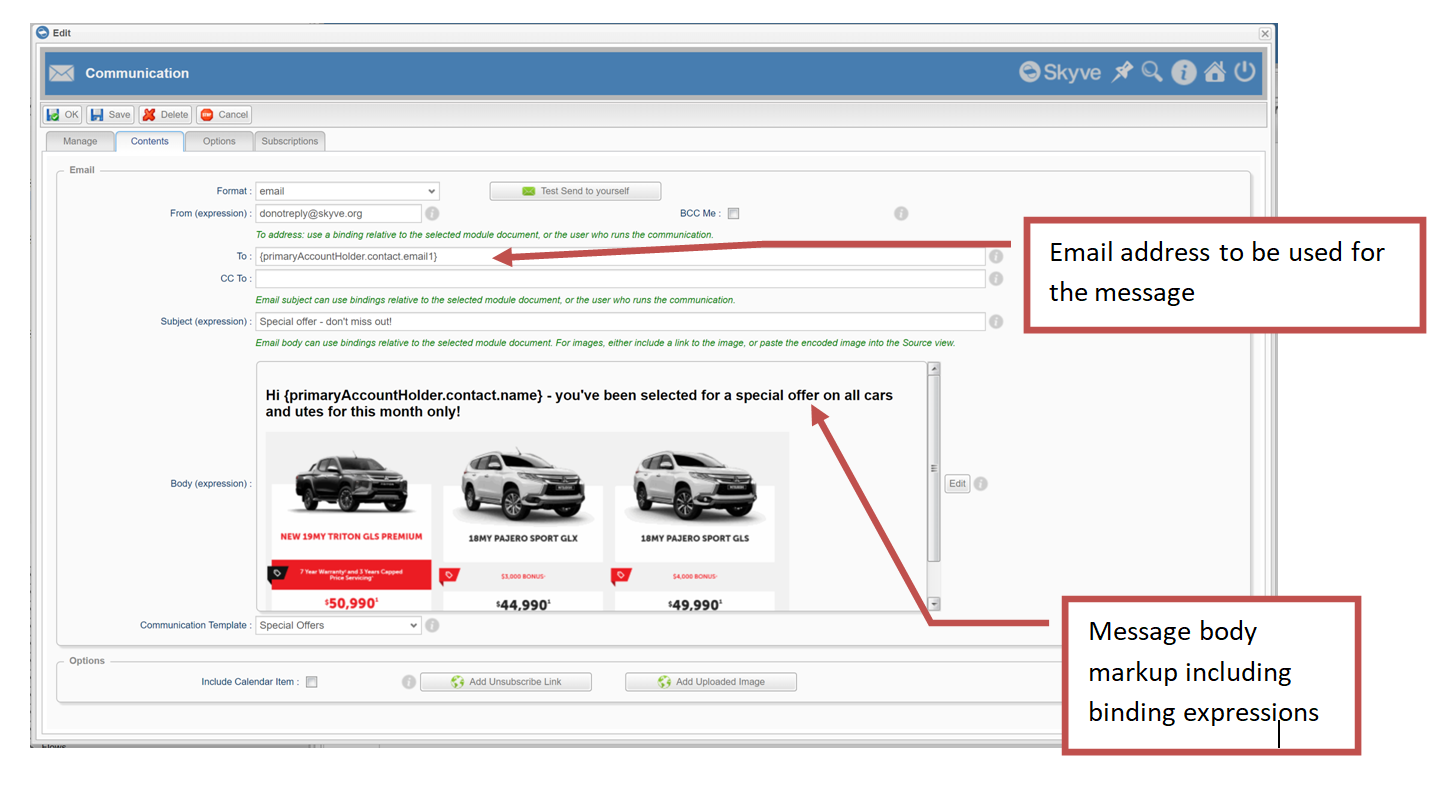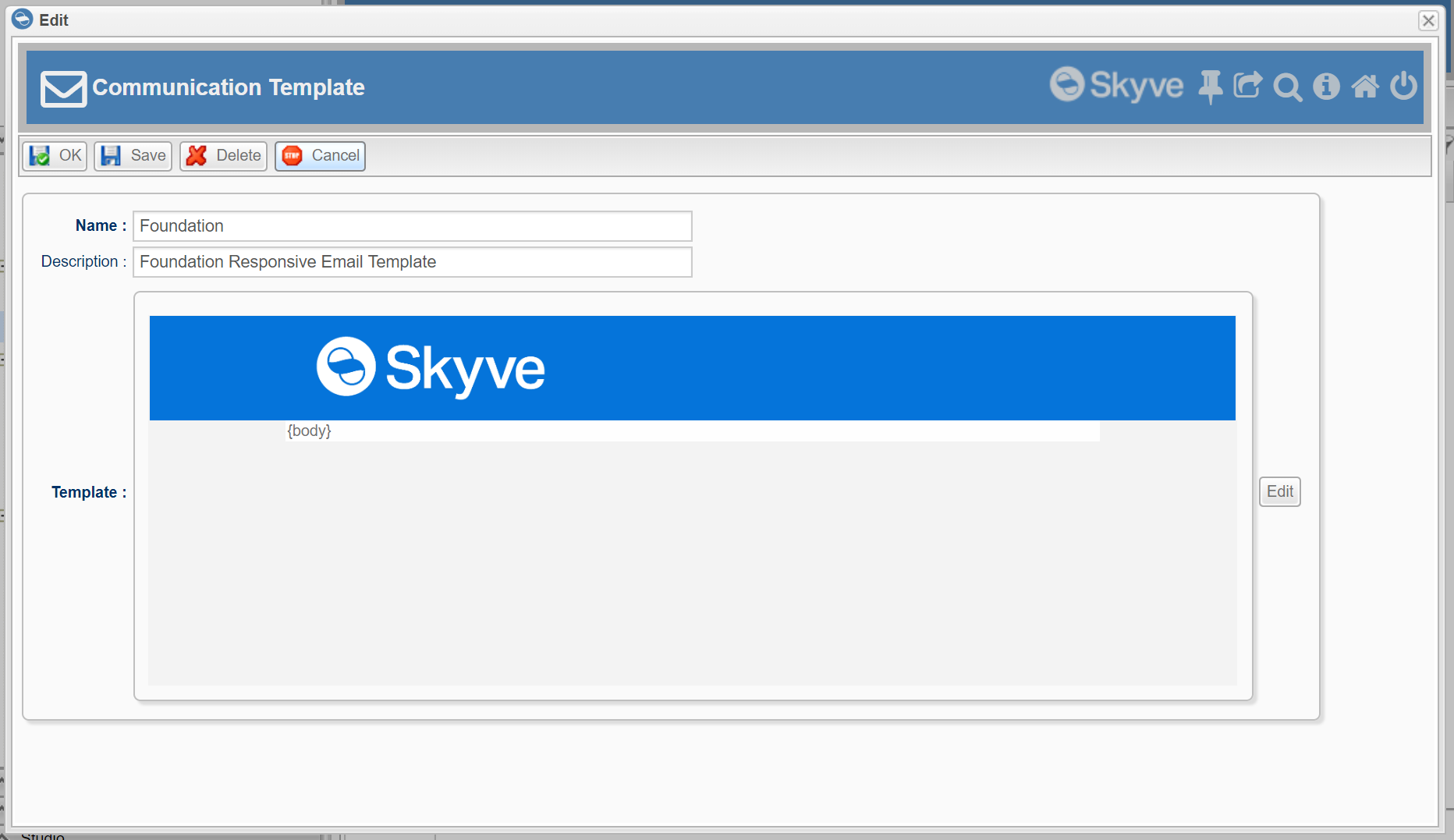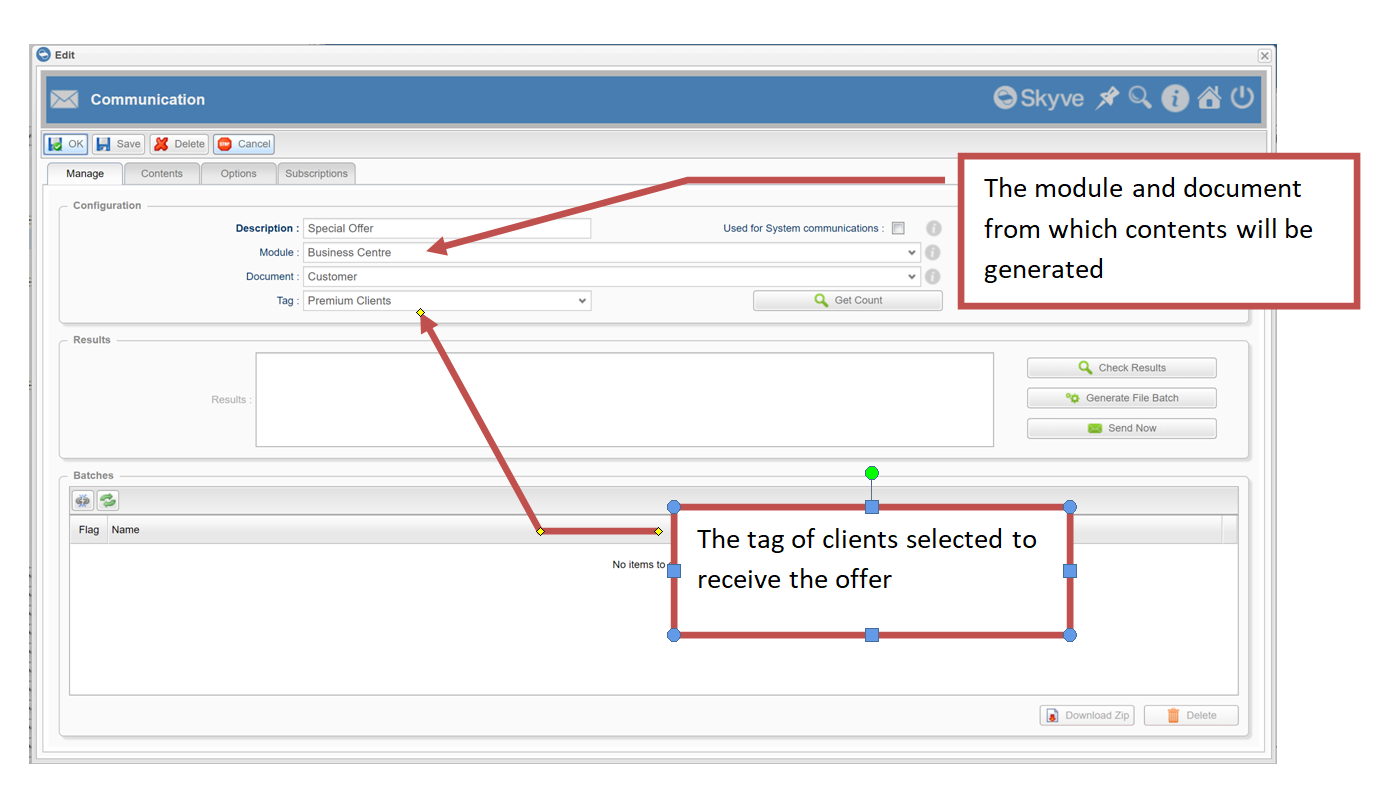Communication
Detailed instructions to send email messages from within a Skyve application are provided in the Skyve User Guide.
The Skyve platform provides a framework for automated and bulk communication, both for user-initiated communications, and for automated communications (initiated in code). The Communication concept is designed to support the design of styling and layout by non-developers even where the the communication is sent by coded or automatic mechanisms. The communication concept is intended to support a variety of communication protocols, with email provided in the open-source distribution.
Skyve communication has built in support for user-definable templates, data bindings, attachments (including stored content items and reports), calendar items and subscription management.
For bulk communications, Skyve takes advantage of the Tag feature - a flexible way to select which records are used as the basis of the bulk communication (for example, which system users should receive the email, or which invoices should be sent).
The Skyve communication framework can send communications immediately via SMTP, or generate the messages as a batch of .eml format files for review and managed sending.
The CommunicationUtil class provides a variety of methods for code-initiated automated communications and the inclusion of attachment items.
Skyve Communication
The Skyve admin module provides the Communication and Communication Template menu items.

A Communication is the definition of a message and how it is bound to application data. The Communication Template contains generic header and footer details for communications - to enable consistent styling - while the Communication contains the binding expressions, body contents and other aspects of the specific message.

For example, a timesheet application may be required to notify a manager when an employee submits a timesheet. The developer creates a Communication called “Timesheet submitted” that provides the subject and body text for an email notification, with binding expressions to substitute for the employee details and the date of the timesheet. The Communication may also include attachments derived from the employee details or the timesheet record. For bound data from the timesheet or employee details, the Communication must specify the relevant module and document so that binding expressions can be resolved.
In this example, the communication will be generated via developer code when the timesheet is first saved with the Status set to Submitted.
Alternatively, an organisation may wish to send a number of clients an email regarding a special offer. Users (at runtime) may select which clients are to receive use the “Special offer” Communication that will include a PDF brochure as an attachment and a link to allow clients to unsubscribe to avoid receiving similar communications in the future.
In this second example, the user may manually initiate the sending step once reviews and checks are complete. The generation of outgoing messages will be managed by a Job which will in turn notify the user once all messages have been generated.
Communication Template
Detailed instructions for creating a Communication Template are available from the Skyve User Guide.
Using a Communication Template is optional - if no template is specified on the communication, the message will simply display the body contents as specified in the Communication body text markup field.
If a Communication Template is specified, the template must contain the {body} tag to identify where the body contents of communication will be located within the generic header/footer layout.
You can create any number of Communication Templates with each Communication specifying the template on which it is based.

Communication management
Detailed instructions to send email messages from within a Skyve application are provided in the Skyve User Guide.
To initiate communications at run-time, the user must specify a module and document and a Tag that contains the specific instances from which the messages will be generated.

The management tab (pictured above) provides a number of management actions:
| Action | Description |
|---|---|
| Get Count | return a count of the number of tagged records (which will correspond to the number of messages to be created |
| Check Results | run a Job to substitute every tagged record and validate whether the binding expressions provided in the Communication contents can be validly substituted |
| Generate File Batch | run a Job to generate email messages as .eml files into a batch folder (which can then be zipped for download) |
| Send Now | run a Job to immediately send all generated email messages. |
If communications are marked as Used for system communications, deleting the Communication is blocked as are changes to the description, module and document settings. (To re-enable these, the Communication must first be saved with the system communications setting turned off.)
The contents tab allows the user to specify the message subject & body.

CommunicationUtil
The CommunicationUtil class provides a number of convenience methods for initialising, generating and sending email communications as well as special expressions.
| Enumeration | Description |
|---|---|
| ResponseMode | (SILENT, EXPLICIT) - whether the runtime user will be notified should an attempt to action a communication (i.e. test, send or generate) fails. If SILENT is set, failures will be logged. If EXPLICIT is set, exceptions will be thrown and success will be notified by a growl (provided a valid webContext is supplied). |
| RunMode | (ACTION,TEST) - For TEST the email binding expressions substitutions will be attempted. For ACTION messages will be generated or sent (as per the ActionType. |
| ActionType | (FILE,SMTP) - Whether to generate .eml files or to send the messages. |
The replacement of binding expressions in the email is based on the Binder.formatMessage() method (see Utility classes), however the CommunicationUtil class provides additional expressions that can be included in binding expressions.
| Expression | Description |
|---|---|
{#url} |
the url for the bean - useful for including a link to the subject bean in the body of the message |
{#context} |
the application context - useful for including a link to the application in the body of the message |
Sending a simple bean-based communication
CommunicationUtil.sendSimpleBeanCommunication() provides a basic convenience method to send a communication from code for a bean (or beans) using binding expressions.
An example method call is provided:
CommunicationUtil.sendSimpleBeanCommunication(
ModulesUtil.currentAdminUser().getContact().getEmail1(),
"Notification Failure",
"Notification failed for bean {#url}",
ResponseMode.SILENT,
FormatType.email,
bean);
Using this method, the Communication is not saved for re-use and the method will attempt to send the email immediately.
Initialising a communication from code
Because developers create application code before Production data exists, Skyve provides a fail-safe way to initialising a communication record so that methods which send automated communications can be relied upon to succeed (providing configuration of the Production system is valid).
The CommunicationUtil.sendFailSafeCommunication() will check if a communication exists and if not, create and safe the communication before using that communication to send the message.
// send invitation email
CommunicationUtil.sendFailSafeSystemCommunication(
UserListUtil.SYSTEM_USER_INVITATION,
UserListUtil.SYSTEM_USER_INVITATION_DEFAULT_SUBJECT,
UserListUtil.SYSTEM_USER_INVITATION_DEFAULT_BODY,
CommunicationUtil.ResponseMode.EXPLICIT,
null,
newUser);
If a communication of the same name has been created prior to the method being called, (and for example styled by a graphic designer), then the existing communication will be used for the method call.
Typical usage pattern
A common (suggested) pattern for usage, is to create a method that uses the initialiseSystemCommunication() method to retrieve the Communication (or instantiate it if it does not already exist), then send it.
/**
* Example email and notification
*/
public void sendNotification() throws Exception {
try {
// send notification email
Communication c = CommunicationUtil.initialiseSystemCommunication(
MyUtil.NOTIFICATION_DESCRIPTION,
MyUtil.NOTIFICATION_SEND_TO,
null,
MyUtil.NOTIFICATION_SUBJECT,
MyUtil.NOTIFICATION_BODY);
CommunicationUtil.send(c, RunMode.ACTION, ResponseMode.EXPLICIT, null, this.getParent(), this);
} catch (Exception e) {
String err = "Notification email FAILED";
Util.LOGGER.warning(err);
}
}
Next Lists
Previous Geometry and geospatial